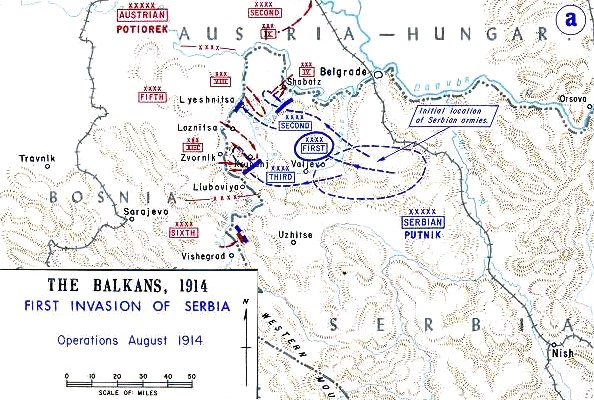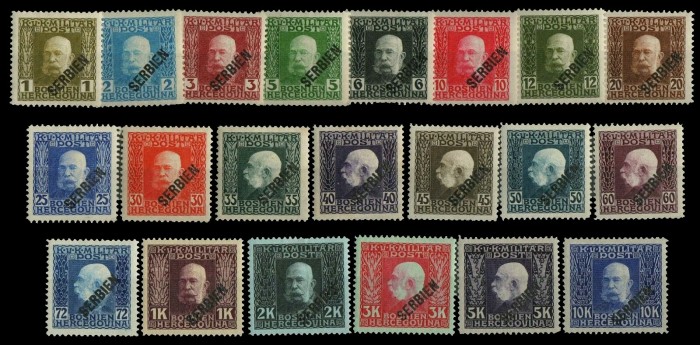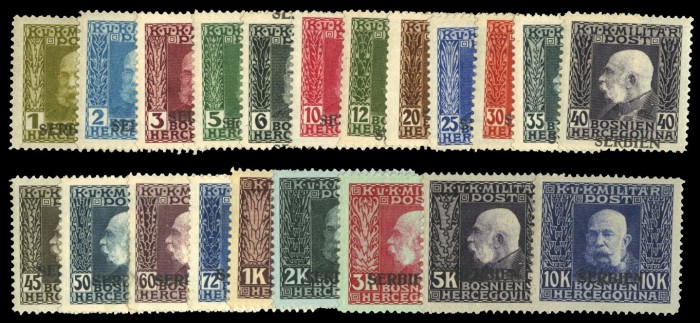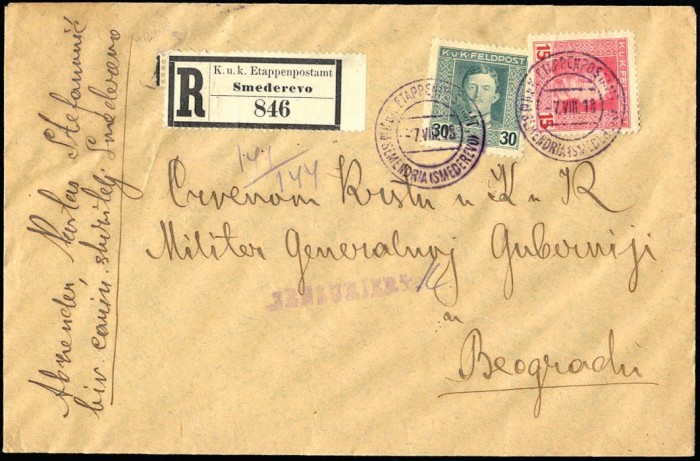What was the Serbian Campaign?
The Serbian Campaign is a bit of a misnomer since it was actually a series of campaigns launched against Serbia at the beginning of the First World War. The first campaign began after Austria Hungary declared war on Serbia on 28 July 1914, the campaign to “punish” Serbia, under the command of Austrian Oskar Potiorek, ended after three unsuccessful Austro-Hungarian invasion attempts were repelled by the Serbs and their Montenegrin allies.

Serbia’s defeat of the First Austro-Hungarian invasion during August 1914 ranks as one of the great upsets of modern military history. It embarrassed Austria’s military leadership and adversely affected the morale of its army
The Second Campaign was launched, under German command, almost a year later, on 6th October 1915, when Bulgarian, Austrian, and German forces, lead by Field Marshall August von Mackensen, invaded Serbia from three sides, pre-empting the Allied advance from Salonica to help her. This resulted in the Great Retreat through Montenegro and Albania, the evacuation to Greece and the establishment of the Macedonian front.
- The defeat of Serbia gave the Central Powers temporary mastery over the Balkans, opening up a land route from Berlin to Istanbul, allowing the Germans to re-supply the Ottoman Empire for the rest of the war
- Mackensen declared an end to the campaign on November 24, 1915
- Serbia was then divided and occupied by the Habsburg Empire and Bulgaria
After the Allies launched the Vardar offensive in September 1918, which broke through the Macedonian front and defeated the Bulgarians and their German allies, a Franco-Serbian force advanced into the occupied territories and liberated Serbia, Albania and Montenegro. Serbian forces entered Belgrade on 1 November 1918.
The Serbian Army declined severely from about 420,000 at its peak to about 100,000 at the moment of liberation. The estimates of casualties are various:
- Serb sources claim that the Kingdom of Serbia lost more than 1,200,000 inhabitants during the war (both army and civilian losses), which represented over 29% of its overall population and 60% of its male population
- Western historians put the number either at 45,000 military deaths and 650,000 civilian deaths or 127,355 military deaths and 82,000 civilian deaths
- According to estimates prepared by the Yugoslav government in 1924, Serbia lost 265,164 soldiers, or 25% of all mobilized people
- By comparison, France lost 16.8%; Germany 15.4%; Russia 11.5%; Italy 10.3%.
Stamps of Serbia (Austrian Occupation)
The Austro-Hungarian occupation of Serbia lasted from 1915 to 1918 but stamps were only issued in 1916. Stamps of Bosnia & Herzegovina (1912 issue) were overprinted “SERBIEN” in black ink. Some spectacular errors exist, e.g. inverted overprints.

1916 Serbia (Austrian Occupation) – full set of 21 values

1916 Serbia (Austrian Occupation) inverted overprints

1916 Serbia (Austrian Occupation) horizontal overprint on the Bosnia & Herzegovina set of 1912 – complete set of 21 stamps
Postal History of Serbia (Austrian Occupation)
Serbia was blamed for starting World War I when, on 28th June 1914, Gavrilo Princip, a Bosnian Serb student and member of a multi-ethnic organisation of national revolutionaries called Young Bosnia, assassinated Archduke Franz Ferdinand of Austria, the heir to the Austro-Hungarian throne, in Sarajevo, Bosnia.
The political objective of the assassination was the independence of the southern Austro-Hungarian provinces mainly populated by Slavs from the Austro-Hungarian Empire, though it also inadvertently triggered a chain of events that embroiled Russia and the major European powers.
- This began a period of diplomatic manoeuvring among Austria-Hungary, Germany, Russia, France, and Britain called the July Crisis. Austria-Hungary delivered the July Ultimatum to Serbia, a series of ten demands intentionally made unacceptable in order to provoke a war with Serbia
- When Serbia agreed to only eight of the ten demands, Austria-Hungary declared war on 28 July 1914

1918 Austrian occupation of Serbia, letter sent by registered mail from Smederevo to Beograd dated 7th August 1918 (with the much more commonly used Austrian military “KUK Feldpost” stamps applied)
In truth, Austria-Hungary precipitated the Bosnian crisis of 1908–09 by annexing the former Ottoman territory of Bosnia and Herzegovina, which it had occupied since 1878. This angered the Kingdom of Serbia and its patron, the Pan-Slavic and Orthodox Russian Empire. Russian political manoeuvring in the region destabilised peace accords that were already unravelling in what was known as “the powder keg of Europe”.
The occupation of Serbia by Austria and Bulgaria was a bitter one and many atrocities took place against civilians. Some of these are recorded by the picture postcards of the time and these form part of the brief postal history, military history and social history of the period.

1917 Austria occupation WWI Serbia, postcard from Glusci with ”BOGATIC FPO” censor

1917 Austria occupation WWI Serbia, postcard from Stojnik with ”SOPOT FPO” censor
Other Stamps / Envelopes / Postcards in this series:
- Stamps of the World – a list of stamp issuing countries (past & present)
- Irish Diaspora Letters – an A-Z list of incoming mail to Ireland from abroad
- Rare Stamps – a list of the rarest stamps in the world (old & new)


